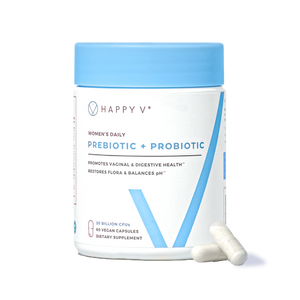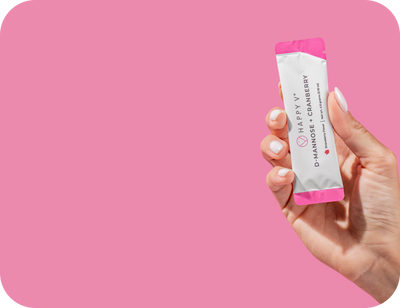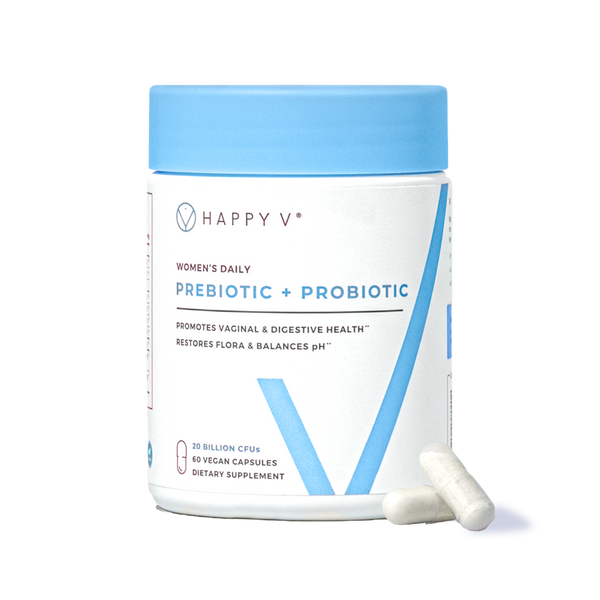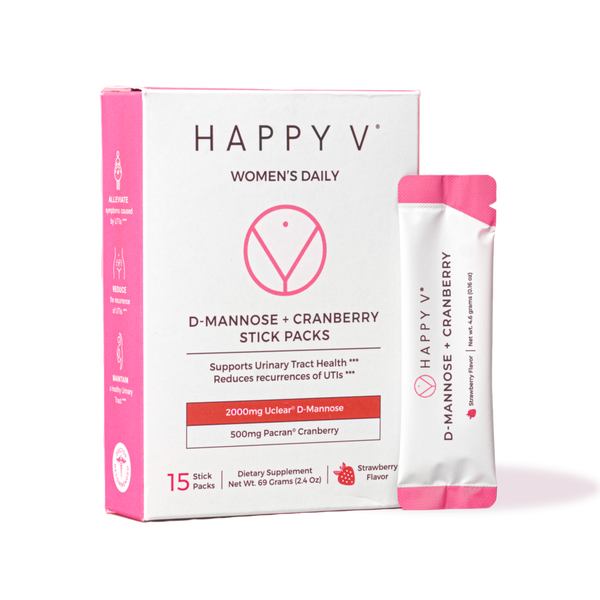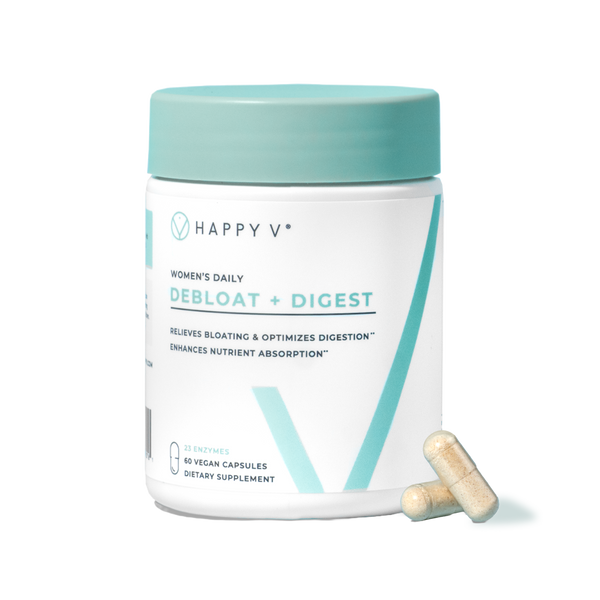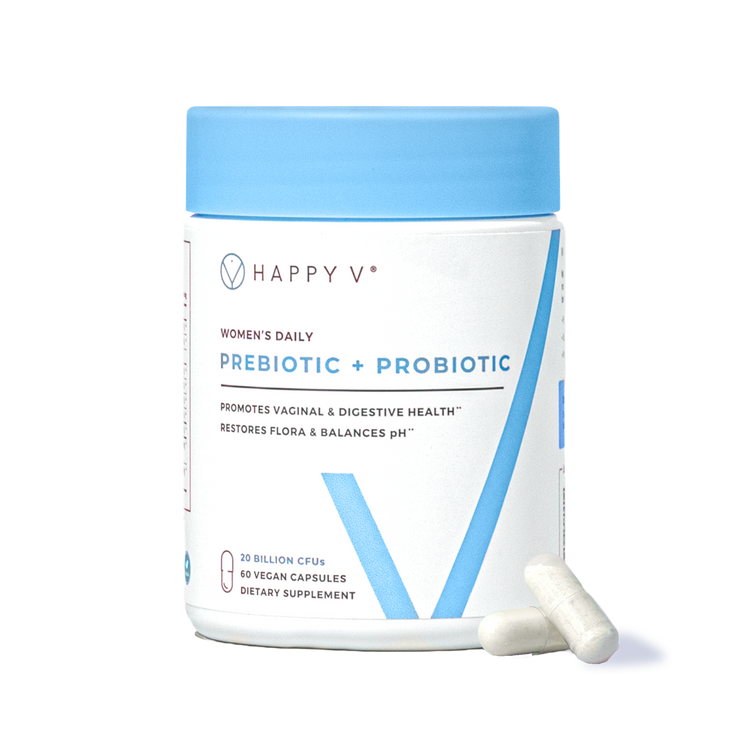- Fact Checked
- May 31, 2025
- 8 min read
How Long Does It Take Fluconazole to Work?
Table of Contents
Table of Contents
When you’re dealing with a yeast infection, every hour can feel like a lifetime1. The itching. The irritation. The when-is-this-going-to-end vibes. If your healthcare provider prescribed fluconazole, you’re probably wondering, “Okay, but how long until I actually feel better?”
We’ve got you. At Happy V, we believe vaginal health should never feel like a mystery. So let’s break down what to expect when taking fluconazole—in plain English, with no awkwardness and zero shame. Because vaginal yeast infections are common, totally manageable, and absolutely nothing to be embarrassed about.
This post is for informational purposes only and does not constitute medical advice. See full disclaimer below.
What Is Fluconazole?
Fluconazole is an antifungal medication used to treat various types of fungal infections, including vaginal candidiasis (aka a vaginal yeast infection) and oral thrush (aka a yeast infection in the mouth or esophagus)2. It belongs to a class of drugs that work by preventing Candida—the yeast that often causes these infections—from growing and reproducing3.
By interfering with the yeast’s cell membrane, fluconazole helps your body rebalance and begin the healing process.
Many people with a history of yeast infections know fluconazole by its brand name Diflucan®4.
How Long Does Fluconazole Take to Work?
The short answer is: it depends.
If you’re treating a vaginal yeast infection, many people begin to notice symptom relief (like reduced itching, irritation, and discharge) within 24 to 48 hours after taking fluconazole. But full recovery may take a few days.
For other Candida infections—like oral thrush or more systemic infections such as peritonitis or cryptococcal meningitis—treatment length and timing vary widely and should be closely monitored by a healthcare provider.
What Can Influence How Fast Fluconazole Works?
If you're not seeing immediate relief after taking fluconazole, you're not alone—and you're not doing anything wrong. Many factors can influence how quickly fluconazole works to clear a yeast infection, and understanding them can help manage expectations and know when to check in with your provider.
1. Type and Severity of Infection
The type of Candida infection you’re treating makes a big difference.
- Mild vaginal yeast infections may respond within 24–48 hours of a single 150 mg dose.
- Oral thrush often needs treatment for up to 14 days.
- Systemic or severe infections (like bloodstream or internal organ infections) can take weeks or even months of higher, sustained dosing.
Example: Someone treating a mild yeast infection might notice improvement overnight. But someone with recurring infections or a more aggressive Candida strain might need multiple doses and longer recovery.
2. Individual Health Conditions
Your immune system plays a big role in how effectively antifungals work.
- People with weakened immune systems may require longer treatment.
- Chronic illnesses, like diabetes or kidney disease, may process medications differently, which can affect how well fluconazole works.
- Age and hormone levels may also influence how the body responds to treatment.
Example: Fluconazole has a longer half-life in individuals with kidney issues, meaning it may linger longer in the system but also take longer to reach therapeutic effect.
3. Drug Interactions
Like many drugs, fluconazole is processed by the liver and can have cross interactions. Speak to a medical professional if you're taking other medications, such as:
- Statins (e.g., atorvastatin)
- Antiarrhythmic drugs (e.g., amiodarone, quinidine)
- Blood thinners
- Certain antibiotics and antidepressants
These interactions may either diminish fluconazole’s effectiveness or increase side effects. Always share your full medication list with your provider.
4. Consistency and Dosage
This may seem obvious, but it's worth being explicit about. If you are ever prescribed fluconazole, it's important that you take the full dose, exactly as prescribed, even if symptoms start to improve. If you miss or skip doses, it can prevent the infection from clearing completely, leading to frustrating reinfections.
If you are worried about missing or forgetting a dose, set an alarm on your phone.
5. Your Vaginal Microbiome
The health of your vaginal microbiome before, during, and after treatment can influence not only how severe your infection is but also how fast you recover.
While antifungals like fluconazole may be necessary to treat an active yeast infection, they can also impact the levels of healthy bacteria in your vaginal, particularly the healthy bacteria Lactobacillus. With low Lactobacillus levels following treatment, you can actually be prone to reinfection.
Many people find that pairing fluconazole treatment with a vaginal probiotic like Happy V that contains clinically studied strains of Lactobacillus like L. acidophilus LA-14® and L. rhamnosus HN001™ helps to support a healthy microbiome and reduce the risk of recurrence.
Prebiotic + Probiotic
Maintains vaginal pH and restores gut health.
Is One Dose of Fluconazole Enough?
In many cases, yes. A single dose of fluconazole (typically 150mg) is enough to effectively treat vaginal yeast infections5. But depending on the type of infection, its severity, and your overall health, your healthcare professional may recommend a second dose a few days later.
If you have recurrent vulvovaginal candidiasis, a weakened immune system, or other chronic medical conditions, a more extended antifungal regimen may be discussed as part of your treatment options6.
What If Fluconazole Doesn’t Work?
If you're not feeling better after a few days, don't panic, but also don't ignore it either. There are a few possible reasons your yeast infection symptoms may be lingering, with the most common being:
-
It Might Not Be a Yeast Infection
Other common vaginal infections like bacterial vaginosis share symptoms with yeast infections, meaning one can often be confused for another. If you started taking antifungals before seeing a healthcare provider, make an appointment so they can make an accurate diagnosis.
-
It Could Be a Resistant Strain of Candida
Some strains of Candida have become less responsive to common antifungals. Luckily, alternatives exist, like voriconazole. These alternatives can only be prescribed by a doctor so make an appointment.
-
Drug Interactions or Missed Doses
Fluconazole can interact with other medications, making it less effective. Always share a full medication list with your healthcare professional before beginning any kind of medical treatment—even commonly prescribed ones! -
You May Need More Support
In some cases, fluconazole may need to be just one part of a larger treatment plan that includes OTC therapies, lifestyle changes, or supportive supplements like vaginal probiotics7.
Common Side Effects of Fluconazole
One of the reasons fluconazole is so common when it comes to yeast infections is not simply because it works, but because most people tolerate it well8. Those that do experience side effects often report minor ones like:
- Stomach pain or abdominal pain
- Headache
- Nausea
- Diarrhea
Serious Side Effects
In rare cases, fluconazole causes serious side effects that require immediate medical attention. These include:
- Allergic reaction symptoms like hives, swelling, or trouble breathing (possible sign of anaphylaxis)
- Unusual bruising or bleeding
- Dark urine or yellowing of the skin or eyes
- Irregular heart rhythm
- Severe skin reactions
Always consult a healthcare provider if you’re experiencing unexpected side effects or suspect an allergic reaction. If you think you’re having a medical emergency, seek medical attention right away.
Can You Take Fluconazole If You’re Pregnant or Breastfeeding?
Fluconazole use during pregnancy or breastfeeding should always be discussed with a healthcare provider. Dosing, timing, and risks depend on the situation, and your provider can help weigh the benefits and potential concerns.
Other Things to Know When Taking Fluconazole
Here are some things to keep in mind when taking fluconazole:
- Don’t mix with alcohol without asking your provider first.
- Always complete the prescribed dose, even if your symptoms improve.
- Be mindful of any drug interactions—check with your pharmacist if you’re unsure.
- If your symptoms return, call your healthcare provider to come up with an alternate treatment plan.
- Consider adding a vaginal probiotic to your routine. Antibiotics and antifungals like fluconazole may impact beneficial bacteria, like lactobacilli, that help support a balanced vaginal microbiome. In preclinical studies, Happy V’s Prebiotic + Probiotic blend —which includes clinically proven strains like L. acidophilus LA-14 and L. rhamnosus HN001—was shown to limit the growth of several Candida species, including candida albicans and glabrata, the main candida strains that cause yeast infections.
- Always check with your healthcare provider before starting any new supplements.
Final Thoughts: Give It a Little Time, and Stay Curious
So how long does fluconazole take to work? For most people treating vaginal yeast infections, you'll feel some improvement within a day or two. But don’t be discouraged if it takes a little longer, especially if it’s your first time taking fluconazole.
If things don’t improve, don’t guess as to what could be going on. Instead, check in with your healthcare provider. They can help you find the best treatment options for your unique situation.
And remember: there’s no shame in being proactive about your vaginal health. You deserve answers, care, and support every step of the way.
Keep the Conversation Going
- Visit our blog for more on BV treatment options and women’s health tips.
- Join our private Happy V Facebook group to hear from others who’ve been there.
- Explore supplements designed to support your vaginal health journey.
Disclaimer: This blog is for informational and educational purposes only and is not intended to diagnose, treat, cure, or prevent any disease. Statements about supplements have not been evaluated by the Food and Drug Administration. For more information about vaginal infections, visit the CDC or speak to a licensed healthcare provider.
